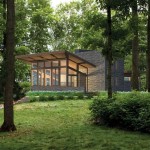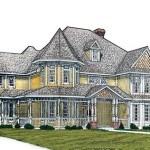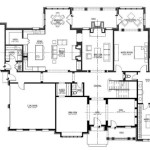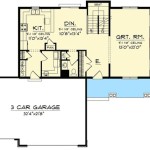A suburban house floor plan is a detailed schematic or layout that outlines the room dimensions, wall placements, and overall design of a house within a suburban area. It serves as a blueprint for constructing and arranging the interior spaces of a suburban home, ensuring efficient use of space and a cohesive flow between rooms.
Suburban house floor plans typically incorporate various rooms and areas, such as bedrooms, bathrooms, kitchens, living rooms, dining rooms, and outdoor spaces like patios or balconies. They may also include designated areas for specific activities or preferences, such as home offices, entertainment rooms, or laundry rooms. The floor plan provides a visual representation of how these spaces are connected and arranged, allowing homeowners and builders to plan the functionality and aesthetics of their suburban home.
Exploring the different types of suburban house floor plans, their advantages and considerations, will help you make informed decisions when designing or selecting a home that best suits your lifestyle and needs.
When designing or selecting a suburban house floor plan, it’s important to consider the following key points:
- Number of bedrooms: Plan for current and future needs.
- Bathroom placement: Ensure accessibility and privacy.
- Kitchen layout: Choose a functional and efficient design.
- Living space: Create comfortable and inviting areas.
- Storage solutions: Plan for ample storage throughout.
- Outdoor space: Consider patios, balconies, or yards.
- Traffic flow: Design a floor plan that allows for easy movement.
- Natural lighting: Maximize natural light to create a bright and airy home.
By carefully considering these factors, you can create a suburban house floor plan that meets your lifestyle and functional needs, while also enhancing the overall aesthetic and comfort of your home.
Number of bedrooms: Plan for current and future needs
Determining the number of bedrooms in your suburban house floor plan is a crucial decision that requires careful consideration of both your current and future needs. Here are some important factors to keep in mind:
- Current family size: Consider the number of people currently residing in your household, including children, guests, and extended family members.
- Future family plans: Think ahead and anticipate any potential changes in your family size. If you plan to have children or welcome elderly parents into your home, you may need additional bedrooms.
- Guest room: If you frequently host overnight guests, a dedicated guest room can provide comfort and privacy for your visitors.
- Home office or study: In today’s remote work environment, a home office or study has become increasingly important. If you require a dedicated space for work or study, consider incorporating an extra bedroom into your floor plan.
It’s generally advisable to plan for one or two additional bedrooms beyond your current needs to accommodate future changes and unexpected circumstances. This foresight will ensure that your suburban house floor plan remains functional and comfortable as your family and lifestyle evolve over time.
Bathroom placement: Ensure accessibility and privacy.
When planning the layout of your suburban house, careful consideration should be given to the placement of bathrooms to ensure both accessibility and privacy for all occupants. Here are some key factors to keep in mind:
Accessibility: Bathrooms should be easily accessible from all bedrooms, especially the master bedroom. Avoid designing a floor plan where bedrooms are located far from bathrooms, as this can be inconvenient and time-consuming, particularly for children, elderly individuals, or guests.
Privacy: Bathrooms should be designed to provide privacy for users. This means situating bathrooms in a way that minimizes the potential for awkward encounters or interruptions. Consider placing bathrooms adjacent to bedrooms or in hallways that are not heavily trafficked.
Master bathroom: The master bathroom, which is typically connected to the master bedroom, should be designed with both functionality and luxury in mind. It should include a private toilet, shower, and bathtub, as well as ample counter space and storage. Consider incorporating a separate dressing area or walk-in closet into the master bathroom suite for added convenience and privacy.
Secondary bathrooms: Secondary bathrooms, which are shared by other occupants of the house, should be designed to accommodate multiple users. This means providing adequate space for each person to use the bathroom comfortably. Consider including double sinks, a separate shower and bathtub, and ample storage space in secondary bathrooms.
Kitchen layout: Choose a functional and efficient design.
Work Triangle Theory
When designing a kitchen layout, the work triangle theory is a fundamental principle that ensures efficiency and functionality. This theory suggests that the three main work areas in a kitchenthe sink, refrigerator, and stoveshould form a triangle with optimal distances between each other. This arrangement minimizes unnecessary steps and allows for a smooth workflow while cooking and cleaning.
Kitchen Island
A kitchen island is a versatile addition to a suburban house floor plan, offering both functional and aesthetic benefits. It can serve as a food preparation area, providing extra counter space and storage. Additionally, a kitchen island can incorporate a sink, cooktop, or seating area, making it a central hub for cooking, dining, and socializing.
Appliance Placement
Careful consideration should be given to the placement of appliances in the kitchen to maximize efficiency and convenience. The refrigerator should be easily accessible from both the food preparation and storage areas. The oven and microwave should be placed at a comfortable height for ease of use. Dishwashers should be situated near the sink for seamless cleanup.
Storage Solutions
Ample storage solutions are essential in a functional kitchen layout. Cabinets, drawers, and pantries should be strategically placed to accommodate cookware, utensils, food items, and other kitchen essentials. Consider incorporating pull-out shelves, lazy Susans, and other organizational features to maximize storage capacity and accessibility.
Living space: Create comfortable and inviting areas.
Comfortable Seating Arrangements
The living room should be designed around comfortable seating arrangements that encourage conversation and relaxation. Consider a combination of sofas, armchairs, and ottomans to create a cozy and inviting atmosphere. Arrange the furniture in a way that allows for easy movement and interaction between occupants.
Focal Point
Create a focal point in the living space, such as a fireplace, large window, or piece of artwork, to draw the eye and provide a sense of purpose to the room. The focal point should be the central element around which the rest of the living space is arranged.
Natural Light
Maximize natural light in the living space by incorporating large windows or skylights. Natural light creates a bright and airy atmosphere, making the room feel more spacious and inviting. Position furniture to take advantage of natural light and create a comfortable and well-lit environment.
Personal Touches
Add personal touches to the living space to make it feel warm and welcoming. Display family photos, artwork, and other meaningful items that reflect your personality and style. Incorporate textiles, such as throw pillows and blankets, to add texture and color to the room.
Storage solutions: Plan for ample storage throughout.
When designing a suburban house floor plan, incorporating ample storage solutions is essential for maintaining a well-organized and clutter-free living space. Here are some key considerations to keep in mind:
Built-in Storage: Built-in storage units, such as cabinets, bookshelves, and drawers, provide a seamless and aesthetically pleasing way to store belongings. They can be customized to fit specific spaces and needs, maximizing storage capacity without compromising on style.
Walk-in Closets: Walk-in closets offer a spacious and organized storage solution for clothing, shoes, and accessories. They can be designed with adjustable shelves, drawers, and hanging rods to accommodate a variety of items. Walk-in closets can be incorporated into bedrooms or hallways, providing easy access to clothing and reducing clutter in other areas of the house.
Under-bed Storage: Utilize the space beneath beds for additional storage by incorporating drawers, rolling bins, or lift-up platforms. This is a great way to store seasonal items, extra bedding, or bulky items that are not frequently used.
Multi-purpose Furniture: Choose furniture pieces that serve multiple functions and incorporate storage options. Ottomans with built-in storage, coffee tables with drawers, and beds with lift-up bases are excellent examples of multi-purpose furniture that can maximize storage space without sacrificing style.
Outdoor space: Consider patios, balconies, or yards.
Suburban house floor plans often incorporate outdoor spaces such as patios, balconies, or yards to extend the living area beyond the interior of the home. These outdoor spaces provide numerous benefits and enhance the overall functionality and enjoyment of the property.
- Patios: Patios are ground-level outdoor areas that are typically constructed of materials such as concrete, pavers, or stone. They offer a versatile space for entertaining guests, dining al fresco, or simply relaxing outdoors. Patios can be covered or uncovered, providing shade or sun exposure as desired.
- Balconies: Balconies are elevated outdoor areas that are typically attached to the upper floors of a house. They provide a private outdoor space with views of the surrounding area. Balconies are ideal for enjoying fresh air, reading, or simply taking in the scenery.
- Yards: Yards are outdoor spaces that surround the house and provide ample room for various activities. They can be landscaped with lawns, gardens, trees, and other features to create a beautiful and functional outdoor oasis. Yards are perfect for children and pets to play, for hosting larger gatherings, or for simply enjoying the outdoors.
- Benefits of Outdoor Space: Outdoor spaces offer numerous benefits to suburban homeowners. They provide an extension of the living area, creating more space for entertaining, relaxing, and enjoying the outdoors. Outdoor spaces can also increase the value of a property and enhance the overall quality of life for residents.
When planning a suburban house floor plan, carefully consider the incorporation of outdoor space. Patios, balconies, or yards can significantly enhance the functionality, enjoyment, and value of your home.
Traffic flow: Design a floor plan that allows for easy movement.
When designing the floor plan of a suburban house, careful consideration should be given to traffic flow to ensure easy and efficient movement throughout the home. A well-planned traffic flow creates a comfortable and functional living environment, maximizing space and minimizing congestion.
Here are some key points to consider when designing a floor plan with optimal traffic flow:
- Clear Pathways: Ensure that there are clear and unobstructed pathways throughout the house. Avoid narrow hallways or doorways that can create bottlenecks and hinder movement. Create
- Defined Spaces: Define different spaces within the house to avoid
- Central Hub: Consider creating a central hub or open area within the house that connects different rooms and spaces. This central hub can serve as a gathering space or a transition point between different areas of the house. A well-placed central hub can reduce the need forand backtracking, improving overall traffic flow.
- Avoid Dead-End Spaces: Dead-end spaces, such as long hallways with no clear exit, can disrupt traffic flow and create a sense of disorientation. When designing the floor plan, aim to avoid creating dead-end spaces and ensure that all rooms and spaces are easily accessible and connected.
By carefully considering these factors and designing a floor plan that optimizes traffic flow, you can create a suburban house that is both functional and enjoyable to live in.
Natural lighting: Maximize natural light to create a bright and airy home.
Incorporating ample natural lighting into a suburban house floor plan is crucial for creating a bright, airy, and inviting living environment. Natural light not only reduces the need for artificial lighting, saving energy, but also provides numerous health benefits, including improved mood, increased productivity, and better sleep. Here are some key considerations for maximizing natural light in your suburban house floor plan:
Window Placement: Strategic placement of windows is essential for optimizing natural light. Position windows on walls that face south or west to capture maximum sunlight throughout the day. Consider installing larger windows or window walls to allow for more light to enter the home. Bay windows and skylights are also effective ways to bring in additional natural light.
Avoid Obstructions: Ensure that windows are not obstructed by trees, buildings, or other structures. Carefully plan the landscaping around your home to avoid blocking natural light sources. Consider trimming trees or using smaller plants that will not interfere with sunlight.
Light-Colored Interiors: Choose light-colored paint and finishes for your interior walls, ceilings, and flooring. Light colors reflect more light, making rooms feel brighter and more spacious. Avoid using dark colors, as they can absorb light and create a gloomy atmosphere.
Mirrors and Reflective Surfaces: Incorporate mirrors and reflective surfaces into your home to bounce natural light around and brighten up darker areas. Place mirrors opposite windows to reflect light deeper into the room. Use glossy or metallic finishes on furniture and accessories to enhance the reflective qualities of your space.










Related Posts








